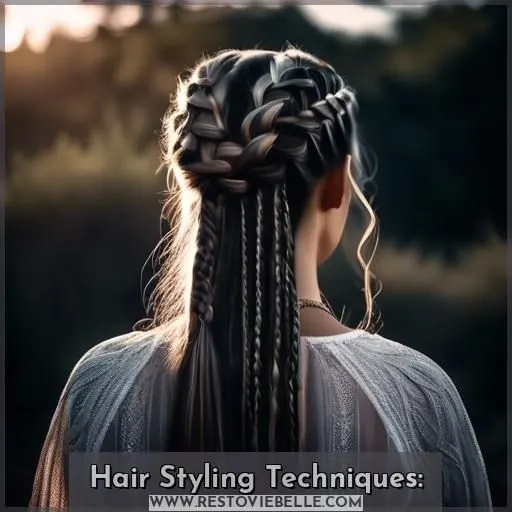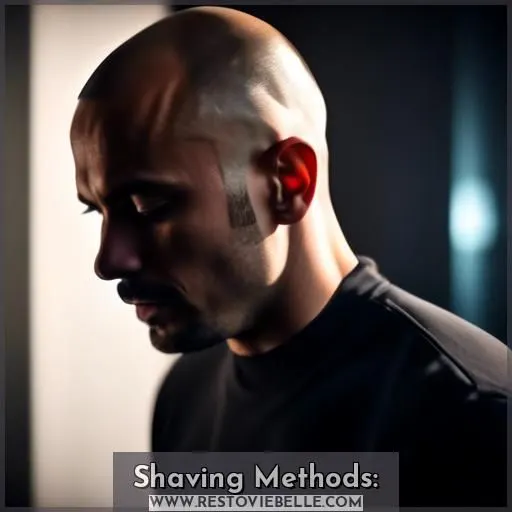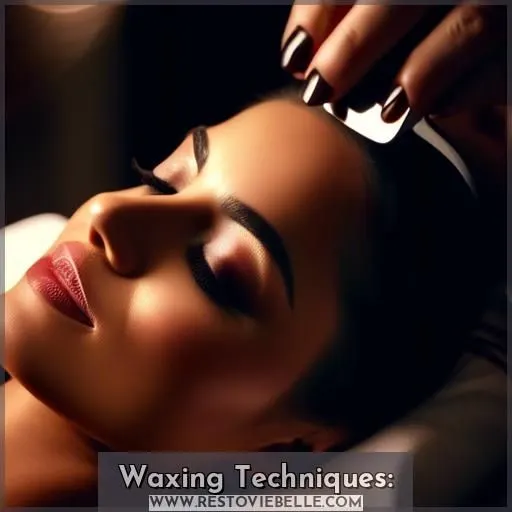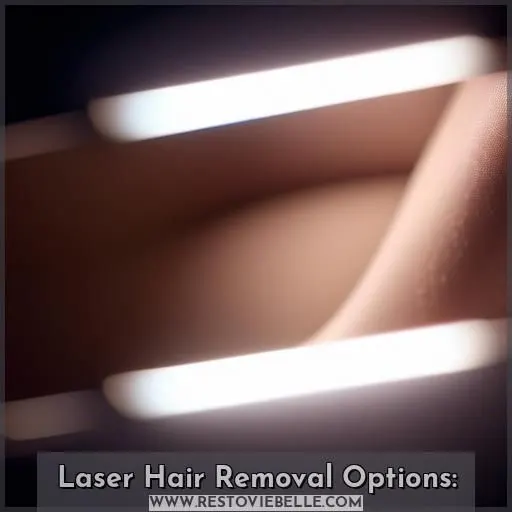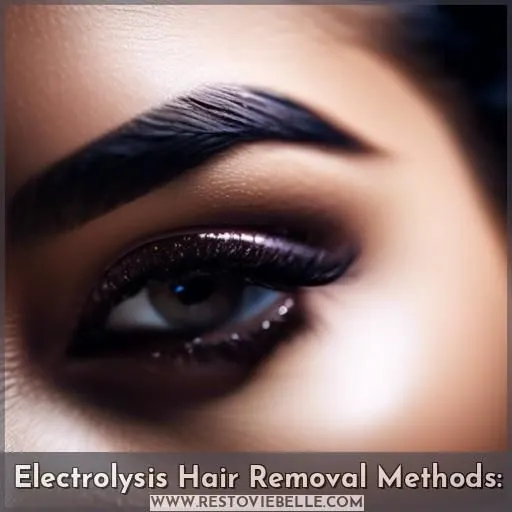This site is supported by our readers. We may earn a commission, at no cost to you, if you purchase through links.
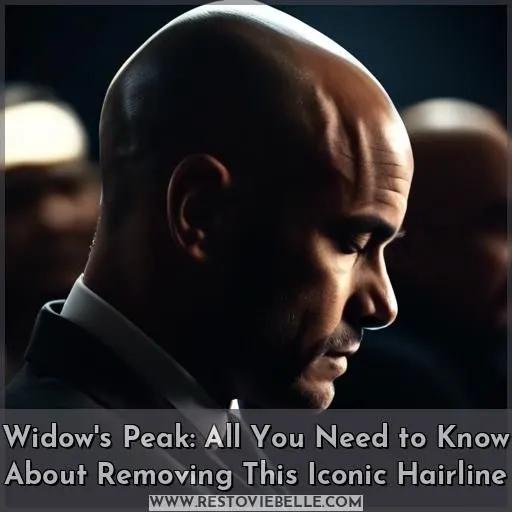 Breaking free from nature’s V-shaped imprint, your widow’s peak, requires strategic artistry.
Breaking free from nature’s V-shaped imprint, your widow’s peak, requires strategic artistry.
Discover surgical and non-invasive paths to tame this iconic hairline.
Master styling techniques, shaving precision, waxing dexterity, laser treatments’ finesse, or electrolysis mastery.
Reclaim control over your aesthetic destiny.
This comprehensive guide empowers you to sculpt your signature look confidently.
Table Of Contents
- Key Takeaways
- How to Get Rid of Widow’s Peak?
- Hair Styling Techniques:
- Shaving Methods:
- Waxing Techniques:
- Laser Hair Removal Options:
- Electrolysis Hair Removal Methods:
- Definition and Characteristics of Widow’s Peak:
- Causes of Widow’s Peak:
- Combination of Genetic and Hormonal Factors
- Genetics: Multiple Genes Control Hair Follicles
- Hair Follicle Configuration: Follicles on Central Forehead Grow Towards Midline
- Periorbital Fields: Zones of Suppressed Hair Growth
- Donnai-Barrow Syndrome: LRP2 Mutation Disrupts Follicular Development
- Opitz G/BBB Syndrome: MID1 Mutation Causes Overgrowth of Frontal Bone
- Meaning and Cultural Significance of Widow’s Peak:
- Frequently Asked Questions (FAQs)
- Conclusion
Key Takeaways
- Experiment with different hairstyles, such as sweeping hair across the forehead or growing it long for a slicked-back look, to conceal the widow’s peak temporarily.
- Consult with a professional stylist for personalized advice on hair styling and removal techniques that suit your widow’s peak.
- Consider permanent hair removal options like laser hair removal or electrolysis if you’re looking for a long-term solution to a widow’s peak.
- Use waxing as a quick and precise method to remove the widow’s peak hair, with results that can last for several weeks.
How to Get Rid of Widow’s Peak?
To get rid of a widow’s peak, you have several options. One is to change your hairstyle, such as growing your hair long or sweeping it to one side. Another option is to use hair removal methods like shaving, waxing, or threading, which can help minimize the appearance of the widow’s peak.
For more permanent solutions, you can consider laser hair removal or electrolysis, which destroy hair follicles to prevent regrowth. If you’re looking for a surgical solution, hair transplantation is also an option, where individual hair follicles are taken from another area of your scalp and implanted on the widow’s peak.
Always consult with a hair restoration professional to determine the best approach for your individual situation.
Hair Styling Techniques:
If you’re looking to conceal your widow’s peak, you can sweep your hair across your forehead to cover the peak or let it grow long for a slicked-back look. Experiment with different hairstyles before committing to a permanent change to find what suits you best.
Sweep Hair Across Forehead to Cover Peak
To style your widow’s peak, consider the following techniques:
- Sweep Hair Across Forehead: This simple yet effective method involves brushing your hair across your forehead to cover the peak. This can be done with a comb or your fingers, and it’s a great way to draw attention away from the peak and towards the rest of your hair.
- Grow Hair Long: If you have long hair, you can style it in a slicked-back look that emphasizes the length and fullness of your locks. This can help downplay the widow’s peak and make it less noticeable.
- Experiment with Different Looks: Don’t be afraid to try out different hairstyles to see what works best for you. You might find that certain styles help hide your widow’s peak, while others draw attention to it.
- Consult with a Stylist: A professional hairstylist can provide personalized advice on how to style your hair to suit your widow’s peak. They can recommend specific cuts and styles that will enhance your features.
- Review Work Before Continuing: Before you make any permanent decisions, take the time to review your hairstyle and consider whether it’s the best option for you. You might find that a different approach works better, or that you prefer a more subtle look.
Grow Hair Long for Slicked-back Look
After sweeping your hair to disguise that iconic peak, why not let it grow and embrace a slicked-back style?
Channel your inner Keanu Reeves or Marilyn Monroe with this classic look.
It’s all about hairline maintenance, using the right hair growth products to keep those locks lush.
For hairstyle inspiration, think of it as sculpting your mane into a work of art.
Experiment With Different Looks Before Making Permanent Decisions
Experimenting with different looks before making permanent decisions is crucial when it comes to managing your widow’s peak.
- Hairstyling Ideas: Try various hairstyles that work well with a widow’s peak, such as side parts, bangs, or volume-boosting techniques. These styles can either accentuate the peak or make it less noticeable, depending on your preference.
- Hair Care Products: Use hair care products that are designed to enhance your hair, such as volumizing sprays or mousse, to create a fuller appearance around the widow’s peak.
- Personal Style: Consider your personal style when choosing hairstyles. If you prefer a more natural look, opt for styles that downplay the widow’s peak, such as growing bangs or using hair products to soften the hairline.
- Long-Term Hair Removal: If you’re considering more permanent hair removal options, consider laser hair removal or electrolysis. These methods can offer long-lasting results, but they may require multiple treatments and may not be suitable for everyone.
- Short-Term Hair Removal: For quick, short-term hair removal, you can try methods like tweezing, waxing, threading, or shaving. These methods can be effective for hiding the widow’s peak temporarily.
- Professional Advice: Consult with a stylist or hair loss expert for personalized advice on how to manage your widow’s peak. They can provide insights into the best hairstyles, hair removal techniques, and hair care products for your specific needs.
Consult With a Stylist for Advice
Consulting with a stylist is an essential step in achieving the desired look for your widow’s peak. A professional stylist can provide personalized advice and expert guidance on hairstyle compatibility, hair removal options, and the best approaches for your specific needs. They can help you navigate the complexities of the realm of hair styling and removal, ensuring that you make informed decisions that are tailored to your unique situation.
When you consult with a stylist, they’ll take the time to understand your hair history, your current hair goals, and your preferences. They’ll ask questions about your hair, such as its texture and current condition, to ensure that they can provide the best advice for your situation. They may also discuss various hair removal options, such as laser hair removal, electrolysis, or hair transplant, to help you determine which method is most suitable for your needs.
In addition to discussing hair removal methods, a stylist can also provide advice on hairstyling techniques that can help you show off or downplay your widow’s peak. They can recommend styles that are designed to enhance your features and make you feel confident and comfortable. Whether you’re looking for a slicked-back look, a more natural style, or something in between, a stylist can help you achieve the look you desire.
Consulting with a stylist isn’t only advisable but also a crucial step in the process of managing your widow’s peak. It can help you avoid the daunting experience of making decisions without proper guidance and ensure that you’re on the right track to achieving your desired look. Whether you’re seeking more than just a haircut or are considering a more permanent solution, a stylist can provide the professional guidance you need to make informed decisions.
Shaving Methods:
If you’re looking to get rid of your widow’s peak, shaving is a quick and easy option. Just be sure to use a sharp razor and shave in small sections to avoid over-shaving.
Use a Straight Razor to Shave the Peak
To shave your widow’s peak with a straight razor, ensure razor safety by checking blade sharpness and using the correct shaving angle.
Prepare your skin with a warm washcloth and apply shaving cream.
Shave small amounts at a time, reviewing your work before continuing.
After shaving, use an aftershave to soothe your skin.
For a V-point shape, consider short-term solutions like waxing or permanent hair procedures like laser or electrolysis.
Perform at Home With Existing Tools
Performing a shave at home can be a daunting task, especially when it comes to the widow’s peak. Safety precautions are crucial, such as choosing the right shaving cream preference and ensuring your razor blade is sharp.
For those without a traditional razor, home tool substitutes like safety razors or electric shavers can be used.
Shave Small Amounts at a Time to Avoid Over-shaving
When tackling that pesky widow’s peak, remember: less is more. Shave small sections to keep from going overboard. A steady hand is your best ally against a crooked hairline. If you’re feeling bold, shaving it all off is an alternative option.
Review Work Before Continuing to Shave
Before continuing to shave, review your work to ensure a meticulous shave. Here are four key steps to follow:
- Pre-shaving preparation: Ensure your skin is clean and dry, and apply a pre-shave oil or cream to soften the hair and protect your skin.
- Shaving mistakes: Be mindful of common mistakes like shaving too quickly or using dull blades, which can lead to cuts and razor burn.
- Safety precautions: Always use a sharp, clean razor and shave in the direction of hair growth.
- Post-shaving care: Apply a soothing aftershave or aloe vera gel to calm your skin and prevent irritation.
Try a Trial Run Before Making a Permanent Decision
| Before making a permanent decision to shave your widow’s peak, it’s wise to do a trial run. Test out different shaving techniques on a small area first. This allows you to see how your skin reacts and ensure you’re comfortable with the process. Take it slow and don’t rush into anything you might regret. | Shaving Trial Run | Benefits | Drawbacks |
|---|---|---|---|
| Test on small area | Assess skin reaction | Time-consuming | |
| Try different techniques | Ensure comfort level | Potential for mistakes | |
| Go at your own pace | Avoid permanent mistakes | Requires patience |
Waxing Techniques:
To remove the widow’s peak, you can use hard wax, which is a quick and precise method that provides results lasting for weeks. You can apply the wax yourself using an at-home kit or visit a professional for a more refined experience.
Apply Hard Wax to the Peak and Remove
When it comes to removing a widow’s peak, waxing is a popular method. Here’s how you can apply hard wax to your widow’s peak and remove it:
- Choose the right wax: Hard wax is best for this task as it adheres to the hair and not the skin, making the removal process less painful.
- Prepare the area: Clean the area thoroughly and ensure it’s dry before starting the process.
- Apply the wax: Apply a thin layer of hard wax to your widow’s peak, ensuring that it covers all the hair in the area.
- Remove the wax: Wait for the wax to cool and harden, then pull it off in the direction of hair growth. This should remove the hair from the root.
- Aftercare: After waxing, avoid touching the area for a few hours to prevent infection. Keep the area clean and moisturized to prevent ingrown hairs.
When deciding between at-home waxing and professional waxing, consider the following:
- Cost: At-home waxing kits can be less expensive than professional services, but the cost can vary depending on the type of wax system you choose.
- Pain level: Professional waxing may be less painful as they’re trained to minimize discomfort.
- Aftercare: Both at-home and professional waxing require aftercare, including avoiding showering immediately after waxing and keeping the area away from the sun.
- Efficiency: Professional waxing may be quicker and more efficient, as they’ve more experience and training.
Quick and Precise Method
Waxing is a quick and precise method for removing widow’s peak hair. It can provide long-lasting results, with waxing sessions typically lasting for weeks.
However, the cost-effectiveness and pain level can vary depending on whether you choose to perform it at home or hire a professional. Home waxing kits can be more affordable, but they may require more effort and skill.
Professional waxing services can offer a more precise and comfortable experience, but they come with an additional cost.
It’s essential to weigh these factors when deciding on the best waxing method for you.
Results Can Last for Weeks
After mastering the quick and precise method of waxing, you’ll revel in the lasting freedom it brings.
- Duration Delight: Enjoy up to three weeks of smooth skin, a liberating break from daily hair removal chores.
- Regrowth Rethink: When hair does return, it’s often finer and less noticeable, giving you an edge in the battle against bristles.
- Time Triumph: Reclaim your mornings, ditching the razor for more sleep or coffee time.
Use an At-home Kit, Hire a Professional, or Visit a Salon
When it comes to waxing methods, you have the option to use an at-home kit, hire a professional, or visit a salon. Home waxing can be a cost-effective solution, but it may require some practice to get the technique right.
Professional waxing, on the other hand, offers precision and expertise, but it may be more expensive. Salon professionals can guide you through the process and provide advice on how to maintain your waxed area.
Ultimately, the choice depends on your comfort level and personal preferences.
Waxing is Not a Permanent Solution
Waxing is a popular hair removal method that involves removing hair by the root, providing long-lasting results. However, it’s essential to understand that waxing isn’t a permanent solution. It can be painful, and the results typically last for a few weeks.
- Pain: Waxing involves pulling hair from the root, which can be uncomfortable. However, the level of pain varies from person to person, and it often lessens with each session.
- Care: Proper care is crucial after waxing to avoid complications such as ingrown hairs, infections, or burns. Exfoliating before waxing, trimming hair to the appropriate length, and following post-wax care instructions are essential.
- Home vs. Professional: Waxing at home can be more cost-effective but carries more risks, while professional waxing ensures a safer experience.
- Cost: The cost of waxing depends on the area being waxed and the type of wax used. Full body waxes are generally the most expensive, while lip waxes are the least expensive.
- Regularity: Regular waxing can lead to less pain and smoother results over time.
Laser Hair Removal Options:
If you’re seeking a more permanent solution, laser hair removal is an option worth exploring. It permanently removes hair in targeted areas, leaving your skin smooth and hair-free. However, it’s crucial to note that laser hair removal works best on dark hair and may not guarantee long-lasting results.
Permanent Hair Removal Option
Permanent hair removal options are popular for those seeking a long-term solution to unwanted hair. Two common methods are laser hair removal and electrolysis.
Laser hair removal uses concentrated light to damage hair follicles, inhibiting future hair growth. It’s suitable for most skin types, but its effectiveness can vary based on hair color and skin tone. Different lasers are used for different skin tones and hair colors, with Nd:YAG lasers being more effective for darker skin tones due to their longer wavelengths.
Electrolysis, on the other hand, uses electrical currents to kill hair follicles, making it a permanent hair removal option. It requires multiple treatments for lasting results and can be uncomfortable, but it’s tailored to individual skin types and hair quality.
When choosing a permanent hair removal method, consider factors such as skin tone, hair quality, and the area of the body being treated. It’s advisable to consult with a professional to determine the most suitable option for your needs.
Best Suited for Dark Hair
If you have dark hair, laser hair removal is a popular choice for permanent hair reduction. However, it’s essential to consider your hair texture, color, and scalp sensitivity before deciding.
Laser pain can vary from person to person, and hair regrowth may not be completely eliminated. It’s not merely a straightforward process; it’s a journey that requires careful navigation of the complexities of your hair and skin.
May Not Guarantee Long-lasting Results
While laser hair removal promises a sleek, hair-free future, it’s not a silver bullet. The long-term effects can vary, with some folks seeing a regrowth that’s thinner but stubborn. It’s a balance of cost-effectiveness and maintenance, requiring a few touch-ups down the line.
Remember, side effects are part of the package, so weigh your options carefully before zapping away.
Hair May Grow Back Thinner and Less Noticeable
When considering laser hair removal, it’s important to know that hair may grow back thinner and less noticeable. This is because the laser targets hair follicles, potentially damaging them and causing them to produce finer hair.
However, results can vary, and some individuals may experience regrowth. Electrolysis, shaving, tweezing, and waxing are alternative hair removal methods that may be more suitable for those seeking a different approach.
Consider Factors Such as Skin Tone and Hair Quality Before Choosing Laser Hair Removal
When considering laser hair removal, it’s crucial to consider your skin tone and hair quality to ensure the best results. Dark hair is best suited for laser treatment, and long-lasting results may not be guaranteed for everyone.
It’s essential to consult with a professional to determine if laser hair removal is the right choice for you.
Electrolysis Hair Removal Methods:
Electrolysis is a permanent hair removal option that uses electrical currents to kill hair follicles. It requires multiple treatments for lasting results and can be uncomfortable, so it’s important to consider your skin tone and hair quality before choosing this method.
Uses Electrical Currents to Kill Hair Follicles
Electrolysis is a permanent hair removal option that uses electrical currents to kill hair follicles.
Consider skin tone and hair quality when choosing electrolysis. The effectiveness of electrolysis varies, and side effects include redness, swelling, and scarring.
The cost of electrolysis can be high, and maintenance is necessary to maintain results.
Requires Multiple Treatments for Lasting Results
Electrolysis is a hair removal method that uses electrical currents to kill hair follicles. It requires multiple treatments for lasting results, which can be daunting for some.
The suitability and affordability of electrolysis vary depending on the individual’s skin tone and hair quality. It’s not merely a one-time procedure; maintenance is crucial to ensure the results last.
It’s advisable to consult with a professional to navigate the complexities of this treatment and tailor it towards your specific needs.
Can Be Uncomfortable
Electrolysis hair removal methods are a permanent solution to unwanted hair, but they can be uncomfortable.
- Precision and Control: Electrolysis targets individual hair follicles, providing precise and long-lasting results.
- Discomfort Level: The procedure can cause temporary discomfort, such as heat or a slight stinging sensation.
- Considerations: Factors like skin tone and hair quality should be taken into account when choosing electrolysis for hair removal.
Consider Skin Tone and Hair Quality When Choosing Electrolysis
Electrolysis is a long-term hair removal method that uses electrical currents to kill hair follicles. It’s a more permanent solution than shaving or waxing, but it can be uncomfortable and requires multiple treatments.
If you’re considering electrolysis, it’s important to consider your skin tone and hair quality. Darker skin tones and coarser hair types may require more treatments and may experience more discomfort.
Electrolysis is a Permanent Hair Removal Option
Electrolysis is a permanent hair removal option that uses electrical currents to kill hair follicles.
When considering electrolysis, it’s essential to consider factors such as skin tone and hair quality. Electrolysis can be cost-effective in the long run, but it may not be suitable for everyone.
Home electrolysis kits are available, but it’s advisable to consult a professional for optimal results.
Definition and Characteristics of Widow’s Peak:
Your widow’s peak is a unique V-shaped hairline in the center of your forehead that’s a result of your genes. It’s a common trait that can vary in prominence and isn’t harmful or advantageous.
V-shaped Hairline Pattern
A widow’s peak is a V-shaped hairline pattern, often considered a family trait, that forms a point at the center of the forehead. This genetic trait is influenced by multiple genes, including the W gene (widow’s peak gene), and isn’t necessarily dominant or recessive. The presence and prominence of a widow’s peak can vary significantly, from subtle to pronounced, and isn’t harmful or advantageous.
Styling a widow’s peak can present challenges, as it may not suit all hairstyles equally. However, there are options to accentuate or minimize its appearance. Some popular hairstyles for people with a widow’s peak include side parts, slicked back looks, and fringes. To accentuate the peak, one can choose hairstyles that pull the hair away from the forehead, such as a slicked back or pompadour style.
Cultural perceptions of a widow’s peak have varied over time and across cultures. While some may associate it with early widowhood or villain-like characteristics, these beliefs aren’t based on scientific evidence. It’s essential to remember that a widow’s peak is a genetic trait and has no specific meaning regarding health or personality.
In summary, a widow’s peak is a distinctive hairline pattern caused by a combination of genetic and hormonal factors. Styling options can help to either accentuate or minimize its appearance, while cultural perceptions should be viewed with a critical and informed perspective.
Genetic Trait
| Your widow’s peak is a unique genetic trait that sets you apart. This V-shaped hairline pattern is inherited, with variations in prominence across individuals. While cultural beliefs may have once associated it with certain characteristics, modern genetic counseling reveals it’s simply a harmless expression of your DNA. Embrace this distinctive feature and let it shine! | Genetic Expression | Inherited Traits |
|---|---|---|
| Your widow’s peak is a unique genetic expression | This V-shaped hairline pattern is an inherited trait | |
| Hairline Variation | Cultural Beliefs | |
| — | — | |
| Variations in prominence across individuals | Cultural beliefs may have once associated it with certain characteristics |
Can Vary in Prominence
Your widow’s peak is as unique as you are, thanks to a cocktail of genetic variations.
- Prominence factors: How pronounced your peak is can vary widely.
- Individual preferences: Some love it, some loathe it.
- Cultural perceptions and fashion trends: What’s in vogue can shape how we feel about our peaks.
Not Harmful or Advantageous
A widow’s peak is a genetic trait that forms a V-shaped point in the hairline at the center of the forehead. It isn’t harmful or advantageous, but rather a unique characteristic that can vary in prominence and be found in both men and women.
Found in Both Men and Women
The V-shaped hairline pattern of a widow’s peak is a genetic trait that can vary in prominence. It’s found in both men and women, not indicating any harm or advantage. Hairline prominence, genetic inheritance, and gender differences influence its appearance.
Causes of Widow’s Peak:
The widow’s peak is a result of a combination of genetic and hormonal factors. The configuration of hair follicles on the central forehead plays a role, as these follicles grow towards the midline.
Combination of Genetic and Hormonal Factors
Your widow’s peak isn’t just a simple genetic trait; it’s a complex interplay of various genetic and environmental factors. It’s not merely a matter of simple inheritance; it’s a complex dance of genes and external influences.
Genetic inheritance plays a significant role in determining your hairline shape. In certain cases, a widow’s peak might result from a recessive trait, meaning both parents need to carry the gene, even if they don’t exhibit the trait themselves. The recessive inheritance could explain instances where a widow’s peak appears in individuals without a direct family history of the trait.
Polygenic inheritance is another factor that can influence the shape and definition of your widow’s peak. This complex interaction of multiple genes can create a wide spectrum of hairline patterns and variations, adding to the diversity and uniqueness of widow’s peaks in the population.
External influences such as nutrition, stress, and hormonal changes can impact how genes related to hairlines are expressed. Epigenetic changes, which are modifications in gene expression caused by factors other than changes in the DNA sequence, can play a significant role in the development of a widow’s peak. These epigenetic influences highlight the dynamic nature of genetics beyond the classic inheritance patterns.
In summary, your widow’s peak is a unique expression of this intricate genetic dance, shaped by a combination of your genetic inheritance, hormonal influences, and environmental factors. Understanding these complexities can help you navigate the realm of hairline variations and embrace your widow’s peak with confidence.
Genetics: Multiple Genes Control Hair Follicles
Understanding the genetics behind your widow’s peak can be a complex journey. Here’s a breakdown:
- Hair follicle genetics: Your hair follicles are influenced by multiple genes, each with its own unique role in hair growth.
- Widow’s peak inheritance: The pattern of your widow’s peak can be passed down through your family, influenced by your parent’s hairlines.
- Familial hair patterns: Your hair follicles may mimic those of your relatives, creating similar hairline patterns.
- Genetic influences on hair growth: Genetics can determine the thickness, color, and growth rate of your hair.
- Hair follicle morphology: The shape and structure of your hair follicles can impact the appearance of your widow’s peak.
Navigating the complexities of hair follicle genetics can be daunting, but understanding these factors can help you better understand your widow’s peak and how it may change over time.
Hair Follicle Configuration: Follicles on Central Forehead Grow Towards Midline
Your hairline’s shape isn’t just a fluke; it’s a tale of genetic inheritance and hair development. Picture the hair follicles on your forehead as tiny soldiers, marching in unison towards the midline, influenced by the growth of your frontal bone.
This orchestrated movement creates the iconic V of a widow’s peak, showcasing unique hair growth patterns etched into your DNA.
Periorbital Fields: Zones of Suppressed Hair Growth
Periorbital fields are the zones of suppressed hair growth that contribute to the formation of a widow’s peak. These areas, located around the eyes, have a significant impact on hair follicle growth patterns.
- Genetics and Hair Follicles: The configuration of hair follicles in the periorbital fields is influenced by genetics, which can lead to the development of a widow’s peak.
- Suppressed Hair Growth: The suppressed hair growth in these zones is a natural part of the hair follicle growth cycle, which can result in a V-shaped hairline pattern.
- Hair Growth and Hair Follicles: Understanding the relationship between hair growth, hair follicles, and the periorbital fields can help individuals make informed decisions about hair removal or styling options.
Donnai-Barrow Syndrome: LRP2 Mutation Disrupts Follicular Development
Donnai-Barrow syndrome is a rare genetic condition that disrupts follicular development, leading to a widow’s peak. The LRP2 gene mutation is responsible for this condition, affecting hair growth and causing the V-shaped hairline pattern.
Understanding the genetics behind this condition can help in seeking appropriate treatment options and navigating the complexities of widow’s peak management.
Opitz G/BBB Syndrome: MID1 Mutation Causes Overgrowth of Frontal Bone
If you’re tired of your prominent widow’s peak and want to explore hair removal options, there are several methods to consider. One option is laser hair removal, which can effectively treat your widow’s peak. However, it’s important to note that the hair on the head is often more difficult to permanently eradicate than hair on the face and body. Another option is electrolysis, which uses electrical currents to kill hair follicles and requires multiple treatments for lasting results.
For a more permanent solution, you may want to consider hair transplantation. This surgical procedure involves moving hair follicles from one part of the scalp to the widow’s peak area, resulting in a reshaped hairline. If you’re seeking a non-surgical, semi-permanent solution, scalp micropigmentation might be an option. This procedure uses microneedles to deposit pigment into the scalp, creating the appearance of a fuller hairline and effectively camouflaging a widow’s peak.
Before deciding on a hair removal method, it’s crucial to consider factors such as your skin tone and hair quality, as these can impact the effectiveness of the treatment. Additionally, it’s advisable to consult with a hair restoration professional to discuss the best solution for your individual needs. Remember, the choice to remove a widow’s peak is a personal one, and it’s essential to weigh the risks and benefits before making a decision.
Meaning and Cultural Significance of Widow’s Peak:
The widow’s peak has no specific meaning regarding health or personality. Its term is derived from a historical belief, and its cultural significance varies across different cultures.
No Specific Meaning Regarding Health or Personality
The widow’s peak, a genetic trait, has no specific meaning regarding health or personality. This hairline feature has been subject to various cultural interpretations over time, but it doesn’t indicate early widowhood or bad luck.
In today’s modern beauty standards, the widow’s peak can be celebrated, styled, or adjusted according to personal preference.
Term Derived From Historical Belief
The term widow’s peak is derived from English folklore. It was believed that this formation was a sign of a woman who’d outlive her husband. The peak refers to the beak or bill of a headdress, particularly a widow’s hood.
This made people think a woman was being given a mourning hood for her husband’s imminent death. It’s also believed to be a sign of sexual prowess in folklore. Men with male pattern baldness develop what appears to be a large widow’s peak.
Cultural Significance Varies
The cultural significance of the widow’s peak varies widely, stemming from historical beliefs and societal interpretations.
This genetic trait, often associated with mystery and allure, has sparked diverse views across different cultures.
While historically linked to notions of fate or luck, today it serves as a unique feature to be embraced or downplayed based on personal preference.
Understanding the blend of genetics and cultural perceptions adds depth to the mystique of the widow’s peak.
Does Not Indicate Early Widowhood
Widow’s peak doesn’t indicate early widowhood. It’s a genetic trait that can vary in prominence and isn’t harmful or advantageous. The term widow’s peak is derived from historical beliefs and has no specific meaning regarding health or personality.
The cultural significance of widow’s peak varies, and it can be styled, celebrated, or adjusted based on personal preference.
Not Necessarily Associated With Baldness
The widow’s peak is a genetic trait that does not necessarily indicate baldness. This misconception likely stems from mythological origins and cultural stereotypes. While the widow’s peak can be inherited, it does not automatically mean one will lose their hair.
Personal experiences can also influence how individuals perceive and approach this hairline feature. It is essential to understand the genetic inheritance and fashion implications of the widow’s peak, rather than relying on unfounded assumptions.
Frequently Asked Questions (FAQs)
Can I use makeup to hide a widow’s peak?
Yes, you can use makeup to hide a widow’s peak. Here’s a simple step-by-step guide:
- Start by applying a styling gel to your hair while it’s still wet, using a medium round brush to dry your bangs from roots to ends. This will help keep your widow’s peak under wraps.
- Next, use a contouring product that’s a shade darker than your skin tone, preferably a matte bronzer or foundation. Apply it to the areas you want to lessen the focus on, in this case, the widow’s peak.
- Blend the contour product well into your skin, using a brush or your fingers, to create a natural-looking shadow that will help hide the widow’s peak.
- Finally, set the contour with a powder or setting spray to ensure it stays in place throughout the day.
How long does laser hair removal last?
Laser hair removal can last for several months to years, but it doesn’t guarantee permanent hair removal. Most people experience hair removal that lasts several months, and it might last for years. However, hair may regrow, particularly if the follicle is damaged but not destroyed during the laser hair removal procedure.
Is electrolysis painful?
Electrolysis is a permanent hair removal method that uses electrical currents to destroy hair follicles. The level of pain associated with electrolysis varies greatly depending on factors such as pain tolerance, the skill of the electrologist, and the equipment being used.
Some people describe the sensation as a tingling or mild discomfort, while others find it more painful, with sensations ranging from a hot prick to a pinch. The pain is usually brief, lasting only a fraction of a second, and the degree of pain can depend on the area being treated, with more sensitive areas like the upper lip generally causing more discomfort.
Electrolysis can be uncomfortable, but the discomfort is often outweighed by the long-term benefits of permanent hair removal.
Can I shave my widow’s peak at home?
Yes, you can shave your widow’s peak at home. However, it requires a steady hand and frequent maintenance, especially if you have fair skin and darker hair.
If you don’t want the hassle of dealing with stubble at your hairline, you might consider a completely shaved head as an alternative.
Remember to perform a small test patch first to make sure it won’t be irritating to your skin.
What is the best way to remove wax from my skin?
To remove wax from your skin, you can use a variety of methods. One effective option is to apply oil to the waxed area. You can use baby oil, massage oil, or olive oil, and hold the soaked cotton pad on the wax residue until it’s saturated, which usually takes about two minutes.
Another method is to use petroleum jelly. Apply a generous layer to the area with wax residue, let it stay for a few minutes, and then wipe the area with a clean cotton pad.
Alcohol can also be used to dissolve or peel off the wax. Dip a cotton pad in alcohol and rub the wax residue in a circular motion until it melts or peels off.
If you have excessively dry skin, it may be helpful to moisturize the area before waxing to prevent the wax from sticking to your skin.
Conclusion
Unleash your inner masterpiece by exploring the diverse paths to tame your widow’s peak. From hair styling techniques to laser treatments, this comprehensive guide empowers you to sculpt your signature look confidently.
Navigate the complexities of the realm of hair removal, and unlock the secrets to a bespoke look that underpins your aesthetic destiny.
